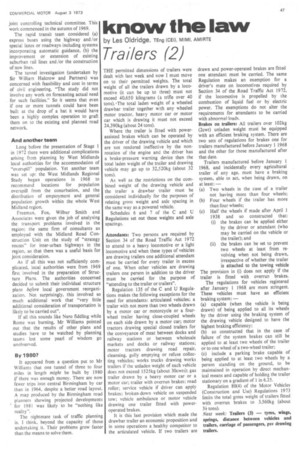know the law
Page 49

If you've noticed an error in this article please click here to report it so we can fix it.
by Les Oldridge, TEng (CEO, MIMI, AMIRTE
Trailers (2)
THE permitted dimensions of trailers were dealt with last week and now I must move on to their permitted weights. The total weight of all the trailers drawn by a locomotive (it can be up to three) must not exceed 40,650 kilograms (a trifle over 40 tons). The total laden weight of a wheeled drawbar trailer together with any wheeled motor tractor, heavy motor car or motor car which is drawing it must not exceed 24.390kg (about 24 tons).
Where the trailer is fitted with powerassisted brakes which can be operated by the driver of the drawing vehicle and which are not rendered ineffective by the nonrotation of the engine and the driver has a brake-pressure warning device then the total laden weight of the trailer and drawing vehicle may go up to 32.520kg (about 32 tons), As well as the restrictions on the combined weight of the drawing vehicle and the trailer a drawbar trailer must be considered individually for the purposes of relating gross weight and axle spacing in the same way as a powered vehicle.
Schedules 6 and 7 of the C and U Regulations set out these weights and axle spacings.
Attendants: Two persons are required by Section 34 of the Road Traffic Act 1972 to attend to a heavy locomotive or a light locomotive and when these types of vehicles are drawing trailers one additional attendant must be carried for every trailer in excess of one. When other vehicles are drawing trailers one person in addition to the driver must be carried for the purpose of "attending to the trailer or trailers".
Regulation 135 of the C and U Regulations makes the following exceptions for the need for attendants: articulated vehicles; a trailer with not more than two wheels drawn by a motor car or motorcycle or a fourwheel trailer having close-coupled wheels on each side drawn by a motor car; motor tractors drawing special closed trailers for the conveyance of meat between docks and railway stations or between wholesale markets and docks or railway stations; motor tractors drawing road repair, cleansing, gully emptying or refuse collecting vehicles; works trucks drawing works trailers if the unladen weight of each vehicle does not exceed 1525kg (about 30cwts); gas trailer drawn by a heavy motor car or a motor car; trailer with overrun brakes: road roller: service vehicle if driver can apply brakes; broken-down vehicle on suspended tow; vehicle ambulance or motor vehicle drawing one trailer fitted with poweroperated brakes.
It is this last provision which made the drawbar trailer an economic proposition and in some operations a healthy competitor to the articulated vehicle. If two trailers are drawn and power-operated brakes are fitted one attendant must be carried, The same Regulation makes an exemption for a driver's mate on locomotives required by Section 34 of the Road Traffic Act 1972, if the locomotive is propelled by the combustion of liquid fuel or by electric power. The exemptions do not alter the requirements for attendants to be carried with abnormal loads.
Brakes on trailers: All trailers over 102kg (2cwt) unladen weight must be equipped with an efficient braking system. There are two sets of regulations for brakes one for trailers manufactured before January 1 1968 and the other for those manufactured after that date.
Trailers manufactured before January 1 1968, and incidentally every agricultural trailer of any age. must have a braking system, able to act, when being drawn, on at least: — (a) Two wheels in the case of a trailer not having more than four wheels; (b) Four wheels if the trailer has more than four wheels; (c) Half the wheels if made after April 1 1938 and so constructed that: (i) the brakes can be applied either by the driver or attendant (who may be carried on the vehicle or the trailer); and (ii) the brakes can be set to prevent two wheels at least from revolving when not being drawn, irrespective of whether the trailer is attached to the towing vehicle The provision in (i) does not apply if the trailer is fitted with overrun brakes.
The regulations for vehicles registered after January 1 1968 are more stringent. These vehicles must have an efficient braking system: — (a) capable (when the vehicle is being drawn) of being applied to all its wheels by the driver using the braking system of the drawing vehicle designed to have the highest braking efficiency; (b) so constructed that in the case of failure of the system brakes can still be applied to at least two wheels of the trailer or to one wheel of a two-wheel trailer; (c) include a parking brake capable of being applied to at least two wheels by a person standing on the ground, to be maintained in operation by direct mechanical means and capable of holding the trailer stationary on a gradient of 1 in 6.25.
Regulation 80(4) of the Motor Vehicles (Construction and Use) Regulations 1973 limits the total gross weight of trailers fitted with overrun brakes to 3,560kg (about 34tons).
Next week: Trailers (3) — tyres, wings, springs, distance between vehicles and trailers, carriage of passengers, psv drawing trailers.
































































































